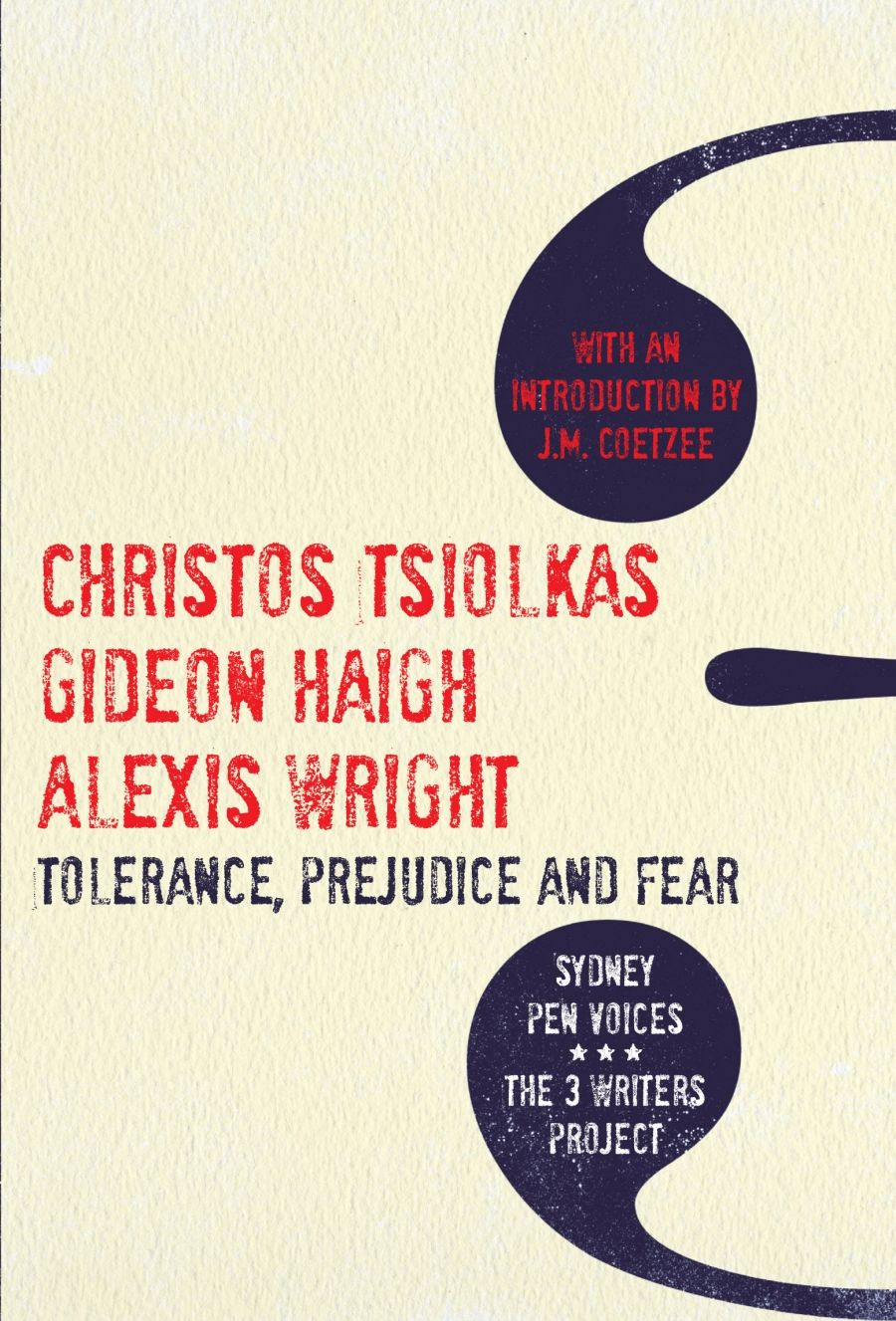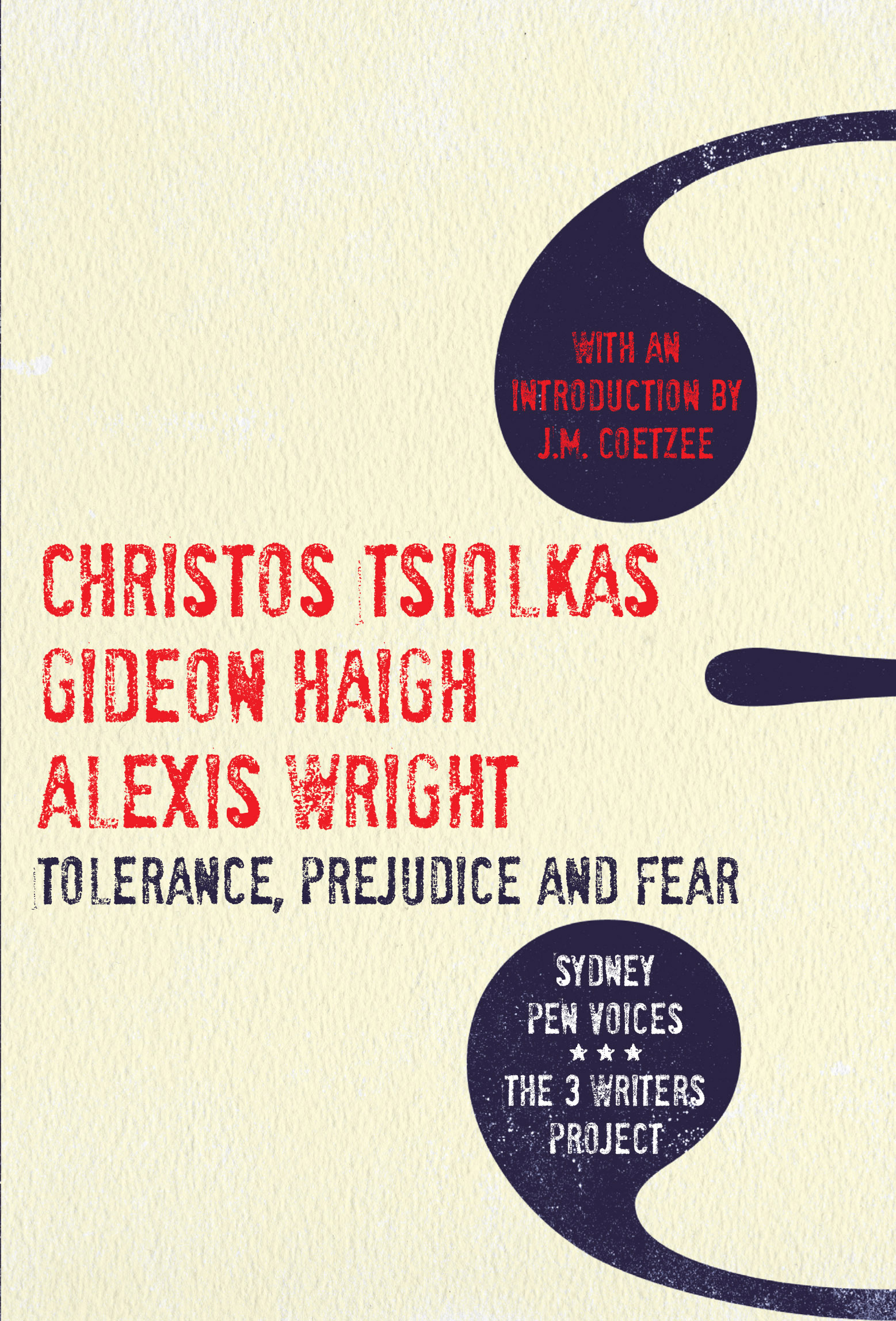
- Free Article: No
- Contents Category: Essay Collection
- Review Article: Yes
- Article Title: Three gadflies
- Online Only: No
- Custom Highlight Text:
Tolerance, Prejudice and Fear comprises a trio of essays commissioned by the Sydney PEN. According to its website, PEN is ‘an association of writers devoted to freedom of expression in Australia’. In this book, three major Australian authors discuss the roles that tolerance, prejudice and fear have played in contemporary Australian society. This is a society in which traditional ideas about national identity and race have been variously championed and attacked. The result is thought-provoking and engrossing.
The text opens with Christos Tsiolkas’s essay on tolerance. Tsiolkas argues that it is no coincidence that a liberal ‘politics of tolerance’ has become popular during an historical period in which neo-conservatism has flourished. Gideon Haigh follows with an essay on the cultural ‘narcissism’ that swept through Australia during John Howard’s eleven years as prime minister. During this period, Haigh argues, Australian culture became ‘shallow, thick-skinned, aloof from the world’s problems, impervious to the sufferings of others – then retracting in angry confusion at the hint of questioning, raging petulantly when crossed …’ The third piece is Alexis Wright’s analysis of the harmful and infectious nature of fear. This is a topic that both Tsiolkas and Haigh raise at different points in their essays. Wright argues that Anglo-Australians have long been socialised to fear ‘Aboriginal people and … law’, while a ‘fearfulness of white Australia’ has arisen within Aboriginal culture. Wright concludes her piece by arguing that literary fiction can offer an effective mode of political resistance in a period when both major political parties in Australia are essentially singing the same neo-conservative tune.
- Book 1 Title: Tolerance, Prejudice and Fear
- Book 1 Biblio: Allen & Unwin, $24.95 pb, 176 pp
- Book 1 Cover Small (400 x 600):

- Book 1 Cover (800 x 1200):

The text opens with Christos Tsiolkas’s essay on tolerance. Tsiolkas argues that it is no coincidence that a liberal ‘politics of tolerance’ has become popular during an historical period in which neo-conservatism has flourished. Gideon Haigh follows with an essay on the cultural ‘narcissism’ that swept through Australia during John Howard’s eleven years as prime minister. During this period, Haigh argues, Australian culture became ‘shallow, thick-skinned, aloof from the world’s problems, impervious to the sufferings of others – then retracting in angry confusion at the hint of questioning, raging petulantly when crossed …’ The third piece is Alexis Wright’s analysis of the harmful and infectious nature of fear. This is a topic that both Tsiolkas and Haigh raise at different points in their essays. Wright argues that Anglo-Australians have long been socialised to fear ‘Aboriginal people and … law’, while a ‘fearfulness of white Australia’ has arisen within Aboriginal culture. Wright concludes her piece by arguing that literary fiction can offer an effective mode of political resistance in a period when both major political parties in Australia are essentially singing the same neo-conservative tune.
All three authors write in a lucid fashion and display considerable passion. Their range of cultural references is remarkably broad. They also draw from the work of figures as diverse as Sigmund Freud, the nineteenth-century French philologist Ernest Renan, and the writers Ursula K. Le Guin and Orhan Pamuk.
Overall, I found Tsiolkas’s essay the most satisfying. Tsiolkas blends moments of elegant critique with such in-your-face lines as ‘In our swimmers, a Greek wog looks very much like a Lebo wog’. He skilfully illustrates the complex relationship between contemporary right-wing politics, disputes over so-called ‘political correctness’, and artistic censorship. Tsiolkas does criticise discourses of ‘tolerance’, though he is not entirely dismissive of them. This is suggested in his endorsement of what he calls ‘radical tolerance’. According to Tsiolkas, this ‘radical tolerance’
insists on a defence of ‘speech’ – of the act of giving voice – even if that voice condemns me, even if that voice argues for annihilation. This is the inescapable implication that arises from reconciling ourselves to the historic failures and mistakes of communism. As writers we cannot afford to … collaborate in a policing of expression and the word.
I was impressed by Wright’s piece on fear. Her call for readers to ‘understand our own level of humanity in the catastrophic picture of what is happening in the world’ is deeply moving. Her argument is also necessary, given the jingoism and white supremacy that continue to permeate Australian society. Wright specifically cites the silencing of Aboriginal voices in the media, as well as our country’s participation in ‘a brutal war against … “the forces of darkness”’, as examples of how fear has been mass-produced in contemporary Australia.
Haigh’s essay is the least successful of the three. His argument on cultural ‘narcissism’ is undeniably a clever one, as is his point about the futility of the distinction between so-called ‘good patriotism’ and ‘bad nationalism’. Haigh does not, however, explain how exactly the concept of ‘prejudice’ is related to his overall argument. Indeed, the very word ‘prejudice’ barely appears in his essay. Perhaps Haigh is trying to suggest that a narcissistic society such as Australia under Howard is one that is filled with prejudices (racial, sexual, economic). That is possible, though he should have made this suggestion more explicit.
More problematically, Haigh’s sophisticated understanding of recent political trends does not extend to his remarks about the worldwide ‘anti-globalisation movement’ that arose during the late 1990s. He rightly points out that the opposition to economic globalisation that defined this movement has also been expressed by the far-right One Nation party. Haigh does not, though, suggest the myriad ways in which the politics of anti-globalisation activists differ from those of Pauline Hanson’s party. Instead, and echoing countless right-wing columnists, he crudely aligns an opposition to globalisation with ‘fascism’.
In fairness, it is not possible to address every issue pertaining to contemporary politics or Western culture in the relatively restricted space of an essay. Haigh is not the only contributor to Tolerance whose arguments have been inhibited by constraints of space. For instance, I felt that much more could have been written about Tsiolkas’s model of ‘radical tolerance’. This is a fascinating topic, and one which has relevance to any debate about censorship and freedom of artistic expression. Similarly, Wright makes the argument that ‘it will increasingly become the role of literature to explain what is happening in the home of humanity, by speaking honestly to the world where those who represent us politically do not’. This argument appears towards the end of her piece, but could have been the subject of a separate essay or even a book.
As a whole, Tolerance is a significant contribution to studies of contemporary Australian politics and society. The essays each have their shortcomings. That said, though, they are all well researched and highly engaging. The myriad topics they raise are worthy of further discussion and debate.


Comments powered by CComment